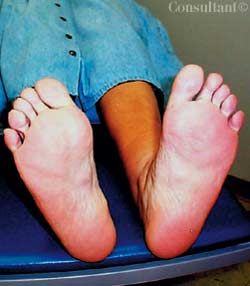Bilateral Nodular Fasciitis
Asymptomatic, enlarging growths had been present on the bottom of a 56-year-old woman’s feet for 3 years. The nodules initially arose-first on the left foot, then on the right-at the sites of blisters on the insteps after the patient had taken a long hike in uncomfortable boots.

Asymptomatic, enlarging growths had been present on the bottom of a 56-year-old woman’s feet for 3 years. The nodules initially arose-first on the left foot, then on the right-at the sites of blisters on the insteps after the patient had taken a long hike in uncomfortable boots.
The patient appeared healthy and was not obese. She had no significant medical history and no relevant family history. Her only medication was hormone replacement therapy. A review of systems was noncontributory; vital signs were normal.
A single soft, movable, nontender, 1-cm subcutaneous mass was noted in the medial midfoot along each longitudinal arch. There was no discoloration. The lesions did not move with flexion or extension of the toes. Dr John A. Mosby of Corpus Christi, Tex, consulted with an orthopedist; bilateral nodular fasciitis was diagnosed.
This benign condition is also called plantar fibromatosis, or Ledderhose disease, and pseudosarcomatous fasciitis.1 The cause is unclear; however, preceding trauma has been noted in some patients. Plantar fibromatosis is similar to the more common Dupuytren’s contracture of the hand, or palmar fibromatosis, in which a nodule forms in the palmar fascia.2
Benign nodular fasciitis may grow rapidly and can be mistaken for a soft tissue sarcoma or, histologically, for a malignant mesenchymal neoplasm. 3,4 Typically, ultrasonography demonstrates a single isoechoic lesion that is no larger than 1 cm in diameter with an inhomogeneous internal structure and a few thin hyperechoic septa. Clear-cut margins with good ultrasonographic beam transmission are characteristic.5
Ossifying, proliferative, and intravascular forms of fasciitis are variants. One study found that the nodular and ossifying forms occurred more commonly in young adults; intravascular fasciitis was more prevalent among men.6
This patient was offered intralesional corticosteroid therapy to inhibit the nodule’s continued growth. Simple excision of the nodule is another treatment option.
References:
REFERENCES:
1.
Sticha RS, Deacon JS, Wertheimer SJ, DanforthRD Jr. Intravascular fasciitis in the foot.
J Foot Ankle
Surg. 1997;36:95-99.
2.
Way LW, ed.
Current Surgical Diagnosis & Treatment
.10th ed. Norwalk, Conn: Appleton & Lange;1994:1180-1181.
3.
Katz MA, Beredjiklian PK, Wirganowicz PZ.Nodular fasciitis of the hand: a case report.
ClinOrthop
. 2001;382:108-111.
4.
Spagnolli G, Pasquali MP, Rosati M, Lisanti M.Nodular fasciitis of the hallux: difficulties in diagnosis.
Acta Orthop Belg
. 1997;63:46-49.
5.
Solivetti FM, Luzi F, Bucher S, et al. Plantar fibromatosis:ultrasonography results.
Radiol Med (Torino)
.1999;97:341-343.
6.
Samaratunga H, Searle J, O’Loughlin B. Nodularfasciitis and related pseudosarcomatous lesions ofsoft tissues.
Aust N Z J Surg
. 1996;66:22-25.